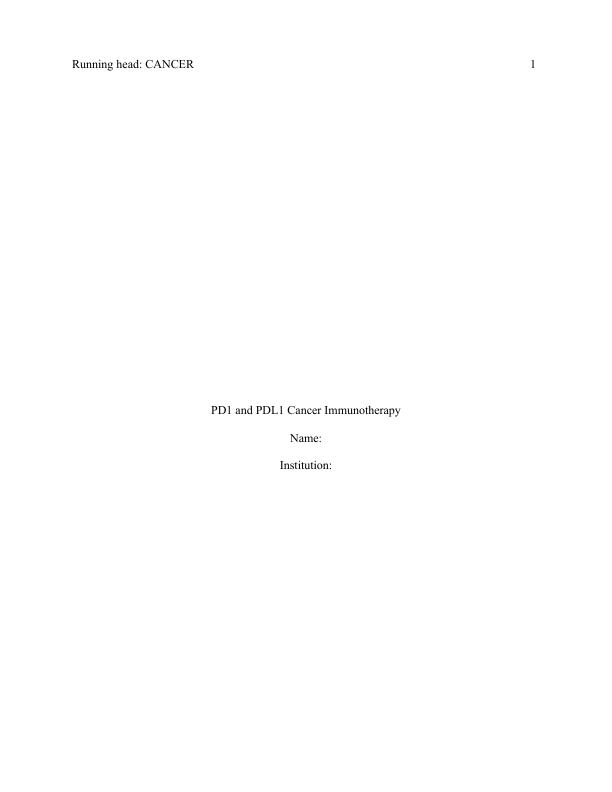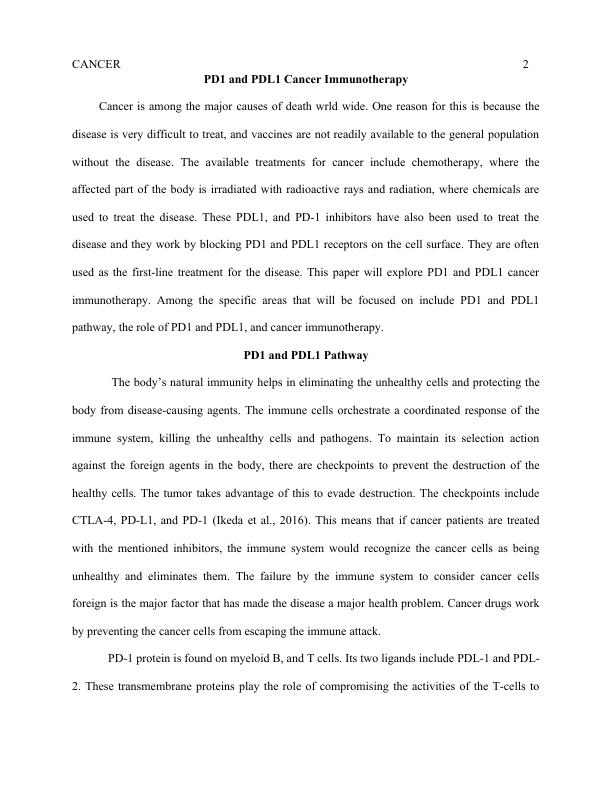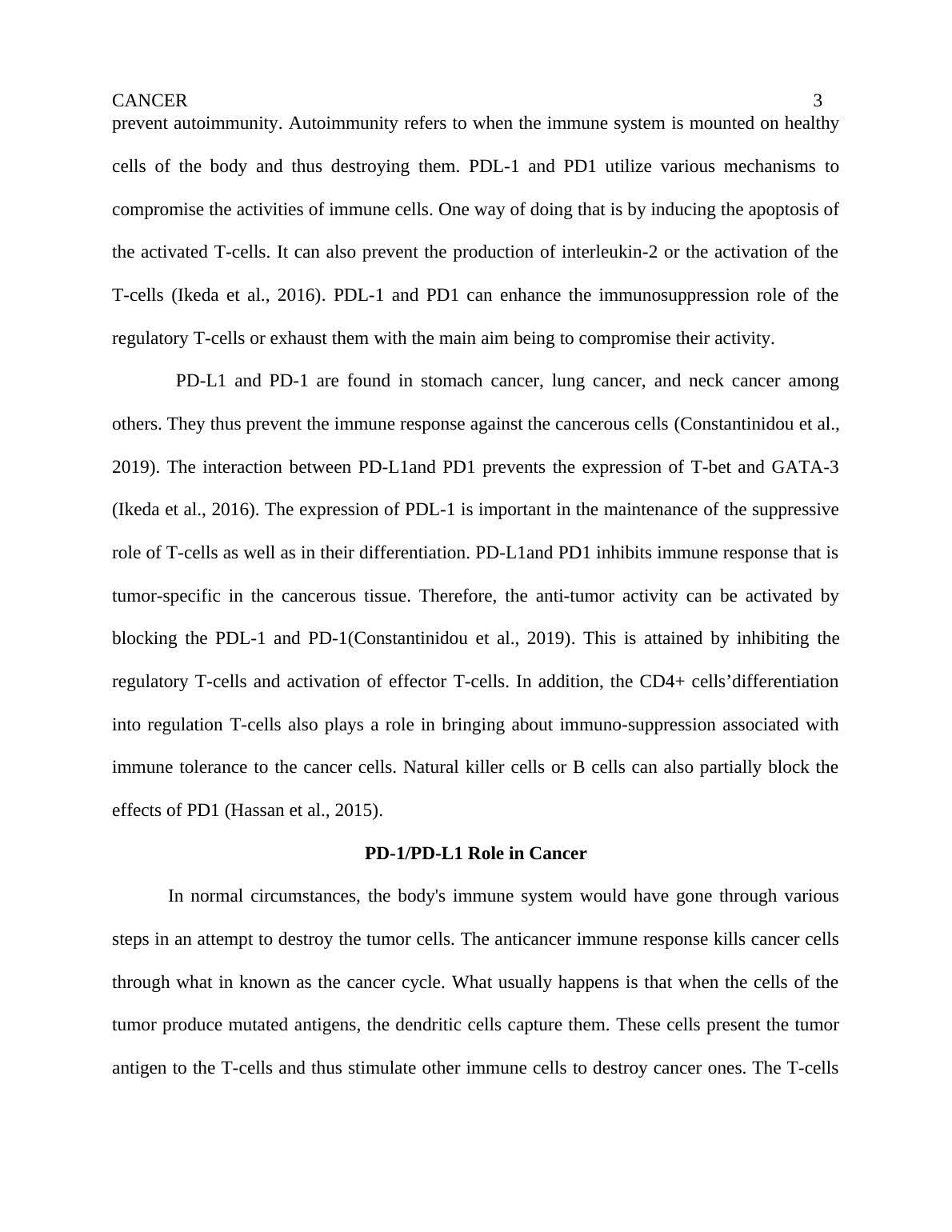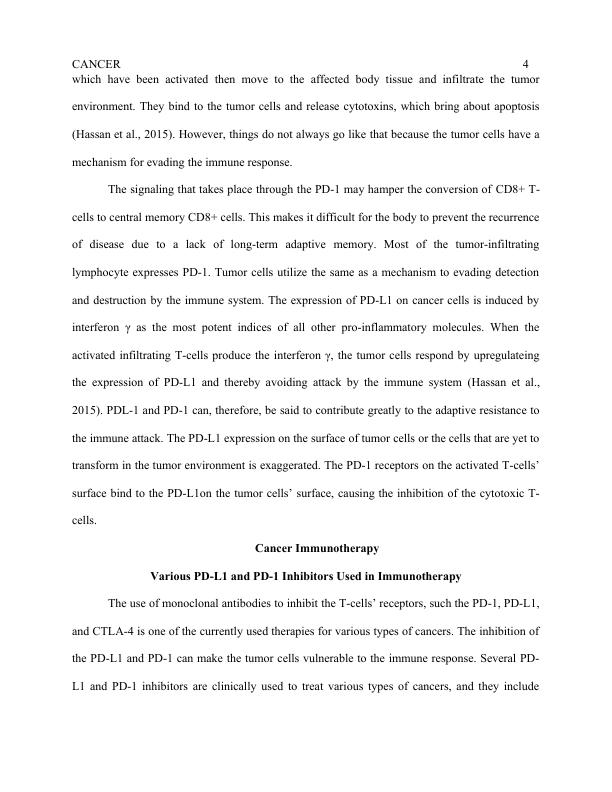PD1 and PDL1 Cancer Immunotherapy
Added on 2022-04-14
11 Pages2957 Words39 Views
Running head: CANCER 1
PD1 and PDL1 Cancer Immunotherapy
Name:
Institution:
PD1 and PDL1 Cancer Immunotherapy
Name:
Institution:

CANCER 2
PD1 and PDL1 Cancer Immunotherapy
Cancer is among the major causes of death wrld wide. One reason for this is because the
disease is very difficult to treat, and vaccines are not readily available to the general population
without the disease. The available treatments for cancer include chemotherapy, where the
affected part of the body is irradiated with radioactive rays and radiation, where chemicals are
used to treat the disease. These PDL1, and PD-1 inhibitors have also been used to treat the
disease and they work by blocking PD1 and PDL1 receptors on the cell surface. They are often
used as the first-line treatment for the disease. This paper will explore PD1 and PDL1 cancer
immunotherapy. Among the specific areas that will be focused on include PD1 and PDL1
pathway, the role of PD1 and PDL1, and cancer immunotherapy.
PD1 and PDL1 Pathway
The body’s natural immunity helps in eliminating the unhealthy cells and protecting the
body from disease-causing agents. The immune cells orchestrate a coordinated response of the
immune system, killing the unhealthy cells and pathogens. To maintain its selection action
against the foreign agents in the body, there are checkpoints to prevent the destruction of the
healthy cells. The tumor takes advantage of this to evade destruction. The checkpoints include
CTLA-4, PD-L1, and PD-1 (Ikeda et al., 2016). This means that if cancer patients are treated
with the mentioned inhibitors, the immune system would recognize the cancer cells as being
unhealthy and eliminates them. The failure by the immune system to consider cancer cells
foreign is the major factor that has made the disease a major health problem. Cancer drugs work
by preventing the cancer cells from escaping the immune attack.
PD-1 protein is found on myeloid B, and T cells. Its two ligands include PDL-1 and PDL-
2. These transmembrane proteins play the role of compromising the activities of the T-cells to
PD1 and PDL1 Cancer Immunotherapy
Cancer is among the major causes of death wrld wide. One reason for this is because the
disease is very difficult to treat, and vaccines are not readily available to the general population
without the disease. The available treatments for cancer include chemotherapy, where the
affected part of the body is irradiated with radioactive rays and radiation, where chemicals are
used to treat the disease. These PDL1, and PD-1 inhibitors have also been used to treat the
disease and they work by blocking PD1 and PDL1 receptors on the cell surface. They are often
used as the first-line treatment for the disease. This paper will explore PD1 and PDL1 cancer
immunotherapy. Among the specific areas that will be focused on include PD1 and PDL1
pathway, the role of PD1 and PDL1, and cancer immunotherapy.
PD1 and PDL1 Pathway
The body’s natural immunity helps in eliminating the unhealthy cells and protecting the
body from disease-causing agents. The immune cells orchestrate a coordinated response of the
immune system, killing the unhealthy cells and pathogens. To maintain its selection action
against the foreign agents in the body, there are checkpoints to prevent the destruction of the
healthy cells. The tumor takes advantage of this to evade destruction. The checkpoints include
CTLA-4, PD-L1, and PD-1 (Ikeda et al., 2016). This means that if cancer patients are treated
with the mentioned inhibitors, the immune system would recognize the cancer cells as being
unhealthy and eliminates them. The failure by the immune system to consider cancer cells
foreign is the major factor that has made the disease a major health problem. Cancer drugs work
by preventing the cancer cells from escaping the immune attack.
PD-1 protein is found on myeloid B, and T cells. Its two ligands include PDL-1 and PDL-
2. These transmembrane proteins play the role of compromising the activities of the T-cells to

CANCER 3
prevent autoimmunity. Autoimmunity refers to when the immune system is mounted on healthy
cells of the body and thus destroying them. PDL-1 and PD1 utilize various mechanisms to
compromise the activities of immune cells. One way of doing that is by inducing the apoptosis of
the activated T-cells. It can also prevent the production of interleukin-2 or the activation of the
T-cells (Ikeda et al., 2016). PDL-1 and PD1 can enhance the immunosuppression role of the
regulatory T-cells or exhaust them with the main aim being to compromise their activity.
PD-L1 and PD-1 are found in stomach cancer, lung cancer, and neck cancer among
others. They thus prevent the immune response against the cancerous cells (Constantinidou et al.,
2019). The interaction between PD-L1and PD1 prevents the expression of T-bet and GATA-3
(Ikeda et al., 2016). The expression of PDL-1 is important in the maintenance of the suppressive
role of T-cells as well as in their differentiation. PD-L1and PD1 inhibits immune response that is
tumor-specific in the cancerous tissue. Therefore, the anti-tumor activity can be activated by
blocking the PDL-1 and PD-1(Constantinidou et al., 2019). This is attained by inhibiting the
regulatory T-cells and activation of effector T-cells. In addition, the CD4+ cells’differentiation
into regulation T-cells also plays a role in bringing about immuno-suppression associated with
immune tolerance to the cancer cells. Natural killer cells or B cells can also partially block the
effects of PD1 (Hassan et al., 2015).
PD-1/PD-L1 Role in Cancer
In normal circumstances, the body's immune system would have gone through various
steps in an attempt to destroy the tumor cells. The anticancer immune response kills cancer cells
through what in known as the cancer cycle. What usually happens is that when the cells of the
tumor produce mutated antigens, the dendritic cells capture them. These cells present the tumor
antigen to the T-cells and thus stimulate other immune cells to destroy cancer ones. The T-cells
prevent autoimmunity. Autoimmunity refers to when the immune system is mounted on healthy
cells of the body and thus destroying them. PDL-1 and PD1 utilize various mechanisms to
compromise the activities of immune cells. One way of doing that is by inducing the apoptosis of
the activated T-cells. It can also prevent the production of interleukin-2 or the activation of the
T-cells (Ikeda et al., 2016). PDL-1 and PD1 can enhance the immunosuppression role of the
regulatory T-cells or exhaust them with the main aim being to compromise their activity.
PD-L1 and PD-1 are found in stomach cancer, lung cancer, and neck cancer among
others. They thus prevent the immune response against the cancerous cells (Constantinidou et al.,
2019). The interaction between PD-L1and PD1 prevents the expression of T-bet and GATA-3
(Ikeda et al., 2016). The expression of PDL-1 is important in the maintenance of the suppressive
role of T-cells as well as in their differentiation. PD-L1and PD1 inhibits immune response that is
tumor-specific in the cancerous tissue. Therefore, the anti-tumor activity can be activated by
blocking the PDL-1 and PD-1(Constantinidou et al., 2019). This is attained by inhibiting the
regulatory T-cells and activation of effector T-cells. In addition, the CD4+ cells’differentiation
into regulation T-cells also plays a role in bringing about immuno-suppression associated with
immune tolerance to the cancer cells. Natural killer cells or B cells can also partially block the
effects of PD1 (Hassan et al., 2015).
PD-1/PD-L1 Role in Cancer
In normal circumstances, the body's immune system would have gone through various
steps in an attempt to destroy the tumor cells. The anticancer immune response kills cancer cells
through what in known as the cancer cycle. What usually happens is that when the cells of the
tumor produce mutated antigens, the dendritic cells capture them. These cells present the tumor
antigen to the T-cells and thus stimulate other immune cells to destroy cancer ones. The T-cells

CANCER 4
which have been activated then move to the affected body tissue and infiltrate the tumor
environment. They bind to the tumor cells and release cytotoxins, which bring about apoptosis
(Hassan et al., 2015). However, things do not always go like that because the tumor cells have a
mechanism for evading the immune response.
The signaling that takes place through the PD-1 may hamper the conversion of CD8+ T-
cells to central memory CD8+ cells. This makes it difficult for the body to prevent the recurrence
of disease due to a lack of long-term adaptive memory. Most of the tumor-infiltrating
lymphocyte expresses PD-1. Tumor cells utilize the same as a mechanism to evading detection
and destruction by the immune system. The expression of PD-L1 on cancer cells is induced by
interferon γ as the most potent indices of all other pro-inflammatory molecules. When the
activated infiltrating T-cells produce the interferon γ, the tumor cells respond by upregulateing
the expression of PD-L1 and thereby avoiding attack by the immune system (Hassan et al.,
2015). PDL-1 and PD-1 can, therefore, be said to contribute greatly to the adaptive resistance to
the immune attack. The PD-L1 expression on the surface of tumor cells or the cells that are yet to
transform in the tumor environment is exaggerated. The PD-1 receptors on the activated T-cells’
surface bind to the PD-L1on the tumor cells’ surface, causing the inhibition of the cytotoxic T-
cells.
Cancer Immunotherapy
Various PD-L1 and PD-1 Inhibitors Used in Immunotherapy
The use of monoclonal antibodies to inhibit the T-cells’ receptors, such the PD-1, PD-L1,
and CTLA-4 is one of the currently used therapies for various types of cancers. The inhibition of
the PD-L1 and PD-1 can make the tumor cells vulnerable to the immune response. Several PD-
L1 and PD-1 inhibitors are clinically used to treat various types of cancers, and they include
which have been activated then move to the affected body tissue and infiltrate the tumor
environment. They bind to the tumor cells and release cytotoxins, which bring about apoptosis
(Hassan et al., 2015). However, things do not always go like that because the tumor cells have a
mechanism for evading the immune response.
The signaling that takes place through the PD-1 may hamper the conversion of CD8+ T-
cells to central memory CD8+ cells. This makes it difficult for the body to prevent the recurrence
of disease due to a lack of long-term adaptive memory. Most of the tumor-infiltrating
lymphocyte expresses PD-1. Tumor cells utilize the same as a mechanism to evading detection
and destruction by the immune system. The expression of PD-L1 on cancer cells is induced by
interferon γ as the most potent indices of all other pro-inflammatory molecules. When the
activated infiltrating T-cells produce the interferon γ, the tumor cells respond by upregulateing
the expression of PD-L1 and thereby avoiding attack by the immune system (Hassan et al.,
2015). PDL-1 and PD-1 can, therefore, be said to contribute greatly to the adaptive resistance to
the immune attack. The PD-L1 expression on the surface of tumor cells or the cells that are yet to
transform in the tumor environment is exaggerated. The PD-1 receptors on the activated T-cells’
surface bind to the PD-L1on the tumor cells’ surface, causing the inhibition of the cytotoxic T-
cells.
Cancer Immunotherapy
Various PD-L1 and PD-1 Inhibitors Used in Immunotherapy
The use of monoclonal antibodies to inhibit the T-cells’ receptors, such the PD-1, PD-L1,
and CTLA-4 is one of the currently used therapies for various types of cancers. The inhibition of
the PD-L1 and PD-1 can make the tumor cells vulnerable to the immune response. Several PD-
L1 and PD-1 inhibitors are clinically used to treat various types of cancers, and they include

End of preview
Want to access all the pages? Upload your documents or become a member.
Related Documents
Emerging Role of Immune Inhibitors and Predictive Biomarkers: Assignmentlg...
|16
|4844
|391
Immunohistochemistry Predictive Markers Reportlg...
|5
|787
|20
Biological Therapy for Cancer Treatment: Immunotherapy and Checkpoint Inhibitorslg...
|15
|3936
|463
Immunotherapies: Types, Interaction with Immune System, and New Developmentslg...
|14
|3475
|195
The Emerging Role of Immune Checkpoint Inhibitors in SCCHN and Predictive Biomarkerslg...
|13
|4145
|332
Effect of Immunotherapy on Ovarian Cancerlg...
|13
|3898
|259
